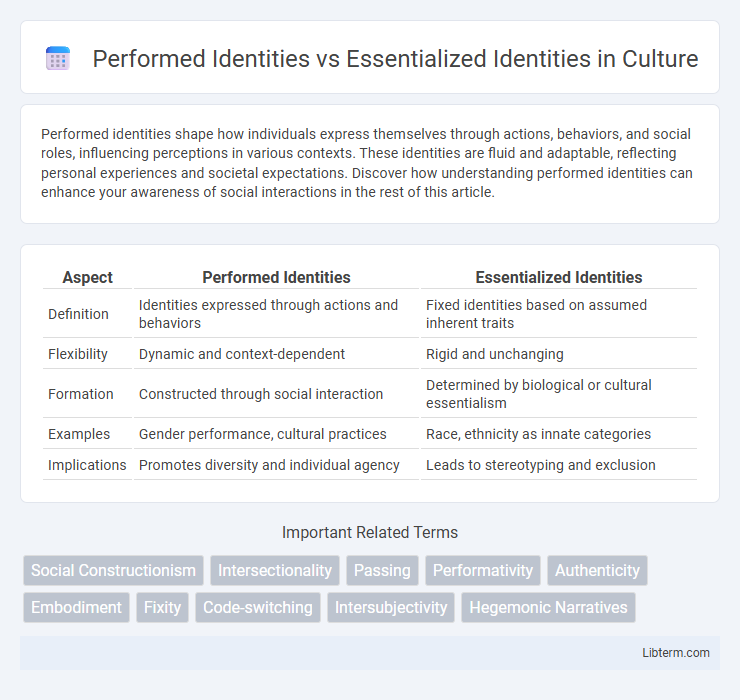Performed identities shape how individuals express themselves through actions, behaviors, and social roles, influencing perceptions in various contexts. These identities are fluid and adaptable, reflecting personal experiences and societal expectations. Discover how understanding performed identities can enhance your awareness of social interactions in the rest of this article.
Table of Comparison
| Aspect | Performed Identities | Essentialized Identities |
|---|---|---|
| Definition | Identities expressed through actions and behaviors | Fixed identities based on assumed inherent traits |
| Flexibility | Dynamic and context-dependent | Rigid and unchanging |
| Formation | Constructed through social interaction | Determined by biological or cultural essentialism |
| Examples | Gender performance, cultural practices | Race, ethnicity as innate categories |
| Implications | Promotes diversity and individual agency | Leads to stereotyping and exclusion |
Understanding Identities: Performed vs Essentialized
Performed identities emphasize the fluid and dynamic nature of identity, highlighting how individuals continuously construct and express their sense of self through actions and social interactions. Essentialized identities, in contrast, treat identity as fixed, innate, and unchanging, often based on perceived biological or cultural traits. Understanding the distinction between performed and essentialized identities reveals how identity is both a personal performance influenced by context and a social categorization that can limit individual expression.
Historical Context of Identity Formation
Performed identities emerge from social interactions and cultural practices, reflecting fluid and situational expressions shaped by historical events such as migration, colonization, and social movements. Essentialized identities, by contrast, are fixed and often imposed through colonial frameworks, racial categorizations, and nationalistic ideologies that seek to define groups based on inherent traits. The historical context of identity formation reveals how power dynamics and historical legacies influence whether identities are seen as performed and adaptable or as essential and immutable.
Theoretical Foundations: Constructionism and Essentialism
Performed identities arise from constructionism, emphasizing identity as fluid, context-dependent, and socially constructed through actions and interactions rather than fixed traits. Essentialized identities stem from essentialism, which posits that certain characteristics and identities are innate, stable, and biologically or culturally predetermined. Theoretical foundations of constructionism challenge static categories by highlighting performativity and social processes, while essentialism maintains fixed, intrinsic attributes as central to identity formation.
Role of Society in Shaping Identity
Performed identities emphasize the dynamic and socially constructed nature of identity, highlighting how individuals enact roles based on cultural norms and social expectations. Society plays a crucial role by providing the scripts, norms, and contexts within which these identities are performed and continuously negotiated. Essentialized identities, in contrast, view identity as fixed and inherent, often ignoring the fluid and interactive influence of social environments on personal and group identity formation.
Media Representation of Performed and Essentialized Identities
Media representation of performed identities highlights the fluidity and adaptability of identity through actions, expressions, and roles individuals choose to portray in social contexts, often challenging fixed stereotypes. Essentialized identities in media reduce complex characters to oversimplified traits based on race, gender, or culture, reinforcing stereotypes and limiting diverse portrayals. Analyzing media narratives reveals a tension between dynamic performed identities that emphasize agency and rigid essentialized identities that perpetuate homogenized, static concepts of identity.
Intersectionality and Hybrid Identities
Performed identities emphasize how individuals actively express and negotiate their identities through social interactions, highlighting fluidity and context-dependence. Essentialized identities treat social categories as fixed and inherent, often overlooking the complex interplay of race, gender, class, and sexuality that intersectionality reveals. Intersectionality and hybrid identities challenge essentialism by showcasing how multiple, overlapping social factors construct unique lived experiences, resisting singular or static definitions of identity.
Implications for Social Inclusion and Exclusion
Performed identities highlight the fluid and dynamic nature of self-presentation shaped by social contexts, enabling individuals to navigate and negotiate inclusion within diverse communities. Essentialized identities, grounded in fixed traits and stereotypes, often lead to rigid social categorizations that reinforce exclusion and limit individual agency. Understanding the tension between performed and essentialized identities is crucial for developing policies and practices that promote genuine social inclusion and challenge discriminatory barriers.
Identity Politics: Performance vs Essence
Performed identities emphasize the fluid, socially constructed nature of identity through repeated actions, gestures, and expressions, highlighting how identity is actively negotiated in social contexts. Essentialized identities, by contrast, treat identity as fixed, innate, and unchanging, often serving as the foundation for identity politics that claim inherent group characteristics and rights. The tension between performance and essence in identity politics influences debates over representation, authenticity, and the politics of inclusion within marginalized communities.
Challenges in Navigating Identity Labels
Navigating identity labels between performed identities and essentialized identities presents significant challenges, as performed identities emphasize fluidity and context-dependent expressions, contrasting with rigid, essentialized labels that assume fixed, inherent traits. Individuals often face social pressure or misunderstanding when their self-identification contradicts stereotypical or institutionalized categories, complicating acceptance and inclusion. This tension highlights the need for flexible frameworks that recognize identity as dynamic, resisting oversimplification and enabling authentic self-representation.
Towards a Fluid Understanding of Identity
Performed identities emphasize the dynamic, context-dependent nature of identity as individuals actively construct and express themselves through social interactions, challenging the notion of fixed traits. Essentialized identities, by contrast, assume stable, inherent characteristics tied to categories like race, gender, or ethnicity, often overlooking individual variability. Moving towards a fluid understanding of identity acknowledges the interplay between social performance and structural influences, recognizing identity as both situationally negotiated and historically grounded.
Performed Identities Infographic

 libterm.com
libterm.com